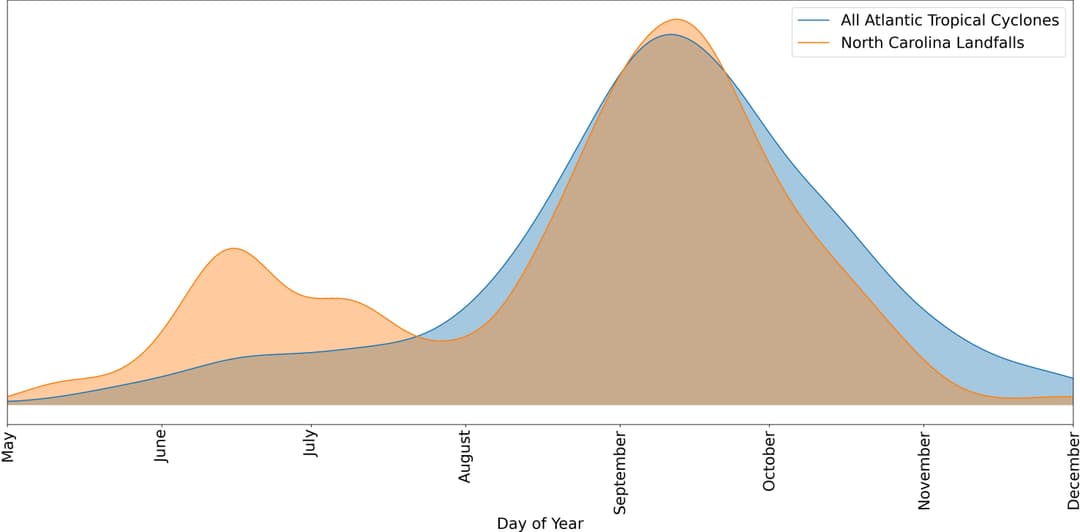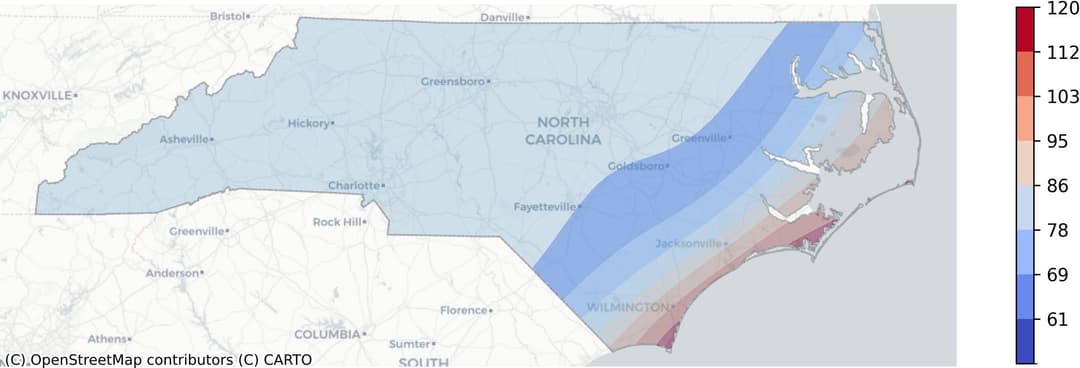Hurricanes in North Carolina
When is Hurricane Season in North Carolina?
The official hurricane season in North Carolina begins on June 1st and ends on November 30th, according to the National Oceanic and Atmospheric Administration (NOAA). This time frame coincides with the Atlantic hurricane season.
Historically, North Carolina hurricanes have had significant impacts, with the state ranking in the top five U.S. states for major hurricane landfalls. From 1851 to 2020, North Carolina experienced 84 hurricanes, out of which 13 were classified as major hurricanes (Category 3 or higher).
The image below provides a visualization based on data from 1851, illustrating the likelihood of North Carolina experiencing a tropical cyclone on any given day of the year. This is juxtaposed against the storm occurrences in the entire Atlantic basin. The data has been sourced from the NOAA Hurricane Research division.

Where Do Hurricanes Hit Most in North Carolina?
In North Carolina, hurricanes predominantly hit the coastal areas, which include the Outer Banks, Wilmington, and the Brunswick islands. These regions are susceptible to hurricane-force winds, storm surges, and floods. The proximity to the Atlantic Ocean makes these areas vulnerable to hurricanes, with the ocean's warm water acting as a fuel source for these powerful storms.

The above graph visualizes the frequency and intensity of hurricanes across North Carolina. Areas highlighted in red indicate regions with a high risk of hurricanes, characterized by frequent occurrences and high wind speeds. Conversely, regions shaded in blue represent areas with a lower risk, marked by less frequent hurricanes with lower wind speeds.
What Are the Recent Hurricanes in North Carolina?
- Hurricane Isaias (2020): Resulted in 10 direct fatalities across the continental United States, including two in North Carolina. It caused significant damage in Horry County, Brunswick County, and the town of Windsor. Over 200,000 residents lost power during the passage of Isaias.
- Hurricane Dorian (2019): Spawned 21 tornadoes across eastern North Carolina, causing significant damage in Brunswick County and Emerald Island. No direct fatalities were reported in North Carolina due to Dorian.
- Hurricane Florence (2018): Resulted in 15 direct fatalities in North Carolina, primarily due to freshwater flooding and wind. Florence caused the worst flooding in local history in Pender County and produced extensive wind damage along the North Carolina coast. The hurricane also resulted in widespread power outages, with 1 million customers losing power in North Carolina. The estimated damage caused by Florence totaled $22 billion.
- Hurricane Matthew (2016): Responsible for 585 direct deaths, 34 of which occurred in the United States, and 18 indirect deaths in the United States. North Carolina experienced significant flooding, with the most affected areas including New Bern, Newport, Belhaven, Oriental, North Topsail Beach, and Jacksonville.
- Hurricane Arthur (2014): Caused significant wind and water damage in Dare and Hyde counties on the Outer Banks. A 26-year-old male drowned in strong waves and residual rip currents off of Nags Head, North Carolina, two days after the passage of Arthur.
- Hurricane Alex (2004): Resulted in significant storm surge damage and beach erosion in Dare and Hyde counties on the Outer Banks. It also caused extensive damage to trees and power lines.
- Hurricane Charley (2004): Directly responsible for ten deaths in the United States, with significant damage observed in Florida, North Carolina, and South Carolina.
How to Prepare for a Hurricane Season in North Carolina
Advance planning for the hurricane season can save lives, prevent injuries, and minimize property damage. With a clear understanding of the potential threats and necessary precautions, residents can significantly enhance their resilience to these severe weather events.
Before a Hurricane
When it comes to hurricane safety, there are several crucial steps to take for effective hurricane preparedness. Here's a general hurricane preparation checklist:
- Stay updated with local news and weather forecasts to monitor the hurricane's path and intensity.
- Secure your property. This may include reinforcing doors and windows, clearing the surrounding area of potential flying debris, and, if necessary, installing storm shutters.
- Prepare an emergency kit. It should contain essential items such as non-perishable food, water, medication, first aid supplies, flashlights, batteries, and important documents.
- Plan an evacuation route and ensure all family members are aware of it.
- Fill your vehicle's gas tank and check its emergency gear, like spare tires and jumper cables.
- Move to a safe location before the hurricane makes landfall. If you choose to stay, identify the safest room in your home to shelter in during the storm.
- Communicate with family members and ensure everyone is aware of the plan.
During a Hurricane
During a hurricane, safety becomes paramount. Here's a list of actions geared toward staying safe during a hurricane in North Carolina:
- Stay informed: Regularly monitor weather updates and alerts from trusted sources.
- Secure your home: Reinforce doors, windows, and any other vulnerable areas to minimize potential damage.
- Stock up: Ensure you have enough food, water, medicine, and other essentials to last at least three days.
- Create an emergency plan: Discuss with your family or household members about what to do, where to go, and how to communicate during a hurricane.
- Evacuate when told to do so: If authorities issue an evacuation order, follow it promptly and safely.
- Stay indoors: If evacuation is not necessary, stay inside, away from windows and doors.
- Avoid flood waters: These waters may be contaminated or electrified. Moreover, it only takes six inches of moving water to knock an adult off their feet.
- Turn off utilities if instructed: Gas leaks and electrical sparks can cause further damage.
- Check on neighbors: Ensure they are aware of the situation and offer help if you can.
- Document property damage: Take photos of any property damage after the storm for insurance purposes.
After a Hurricane
Knowing what to do after a hurricane is just as important as preparing for one. Your safety and recovery should be your top priority when a hurricane has passed. Here's a short list of steps to follow:
- Ensure safety: Check everyone in your household for injuries. Avoid hazards like fallen objects, downed electrical wires, and gas leaks.
- Assess damage: Once it's safe, evaluate the damage to your home and property. Document these damages with photos or videos for future reference.
- Contact authorities: Report any serious damages to local authorities. If you need immediate help, don't hesitate to contact emergency services.
- Reach out to FEMA: The Federal Emergency Management Agency (FEMA) can provide assistance. You can apply for help online, by phone, or at a Disaster Recovery Center.
- File insurance claim: Contact your insurance company to file an insurance claim. Provide them with your documented evidence of the damage.
- Clean and repair: Start the clean-up process. Be aware of potential health hazards, like contaminated water or mold growth.
- Seek help if needed: Reach out to local relief organizations for help with food, housing, and other immediate needs.